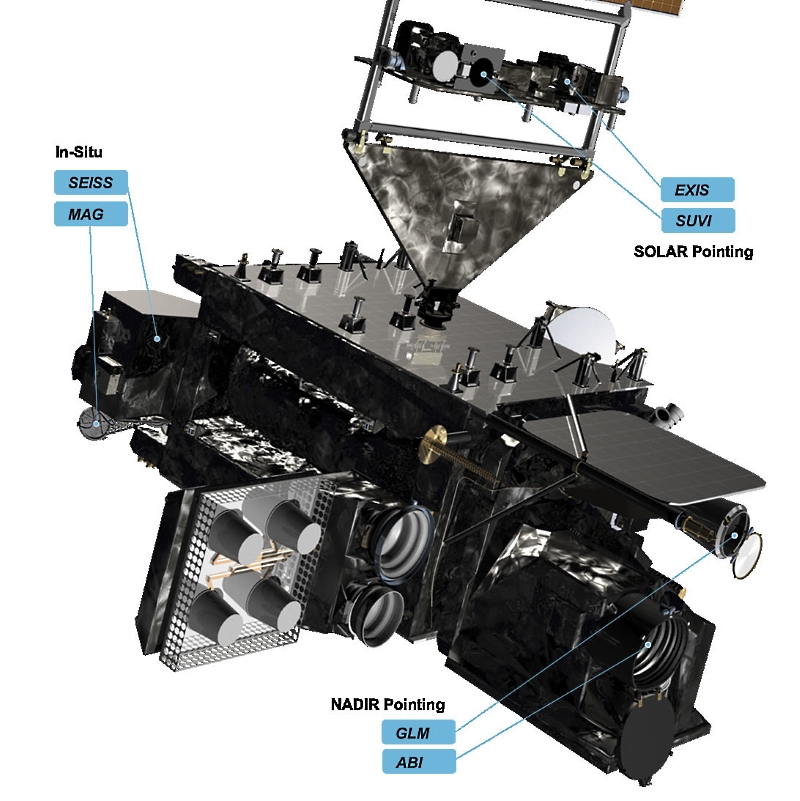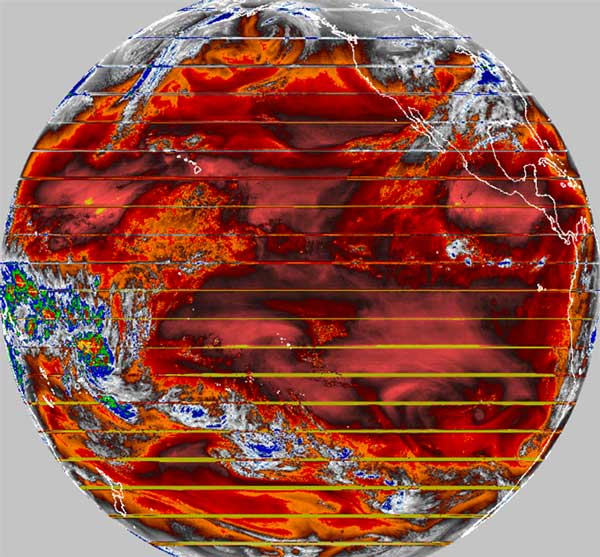As the saying goes, "in the wake of our publications." A year ago, I
talked about the accident detected on the US meteorological satellite GOES-17 - its infrared sensor did not cool well. Last week, NASA released an incident investigation report. Unfortunately, we will not see the full document - it contains commercial and state-protected secrets, an
abridged version is published. The established reason is commonplace - foreign solid particles in the working fluid clogged the tubes.
 Tropical storm Barbara through the eyes of GOES-17, July 1, 2019, NOAA photo, full size even more beautiful
Tropical storm Barbara through the eyes of GOES-17, July 1, 2019, NOAA photo, full size even more beautifulFight for survivability
GOES-17 is the second satellite of the fourth generation of US geostationary meteorological satellites. His brother, GOES-16, has been in orbit since 2016. The main instrument of the devices is the Advanced Baseline Imager (ABI) operating in 16 ranges. This is a big progress - third-generation satellites worked with 5 bands. And the more ranges, the higher the quality of the information received - trees, fires, humidity are better visible in "their" wavelengths.
 GOES-16/17 close-up, image of NOAA
GOES-16/17 close-up, image of NOAAGOES-17 was launched on March 1, 2018. After 12 days, it reached the geostationary orbit. It took some time to prepare the equipment for work, and on April 13, the lens cover of the main ABI tool was opened. Suddenly, surprises began - in the area of the orbit where the lens was illuminated by the Sun, heat pipe coolers began to turn on themselves. This was unexpected, but the automation was considered normal. Problems began on April 28, when coolers were turned on for regular activation of ABI. After 15 minutes, the evaporator temperature (a sign of cooling efficiency) fell from 19 ° C to 13 °, at the expected -3 ° C, and then began to rise again.
There are two heat pipes on the satellite, and the next day they tried to test them separately. After spending three days, the MCC found that the first tube works a little better than the second, but both of them transfer too little heat to cool the sensor normally. On May 16, the satellite was turned so that the Sun did not shine on the radiator, but this did not improve the situation. May 23 had to officially announce the anomaly. Since the end of spring, several teams began to work, one engaged in the investigation of the incident, the other in attempts to squeeze the maximum out of "non-pulling" equipment.
 Example of a defective frame from an overheated GOES-17 sensor, source
Example of a defective frame from an overheated GOES-17 sensor, sourceFor normal operation, the infrared sensor must be cooled. An overheated sensor will produce an absolutely unusable picture (above). In the ABI instrument, 2 channels operate in the visible range, 4 in the near infrared and 10 in the infrared, so cooling problems mean a periodic lack of information from 13 of 16 ranges. In a few months, the optimization team was able to modify the operating modes of the equipment, and about 97% of the data can still be obtained. The satellite was announced operational February 12, 2019.
 An example of a partially usable frame. Some of the information is blocked by stripes, and in general the picture has more noise, but such an image can still be used
An example of a partially usable frame. Some of the information is blocked by stripes, and in general the picture has more noise, but such an image can still be used3% inaccessibility is a little less than 11 days a year. It seems to be small, but the requirements for the satellite indicate no more than 6 hours of inaccessibility of tools. To estimate the losses incurred, 3% of inaccessible data from $ 100 million spent on the satellite resulted in losses of $ 3 million, which puts the accident in the highest type A according to NASA classification (losses more than 2 million).
The thing is the pipe
 Cooler circuit source
Cooler circuit sourceStructurally, the ABI cooling system is a heat pipe circuit with a remote heat exchanger. The coolant (propylene) evaporates in the evaporator, taking thermal energy with it. In the gaseous state, it passes through the heat exchanger, enters the condenser, where it becomes a liquid, and, due to the capillary effect, begins to move in the opposite direction. Passing through the heat exchanger, it is heated, partially gasified, but again becomes liquid in the subcooler. This option allows you to more accurately withstand the desired temperature, but has the disadvantage of longer pipelines.
 Cooler for ABI, source
Cooler for ABI, sourceThe commission of inquiry studied telemetry, documentation, and paid visits to contractors. The immediate reason was clear - coolers instead of the required 390 watts diverted only 10-20 watts. But with the answer to the question why it was so, it was more difficult. Different versions were considered, from mechanical damage to the tubes to non-calculated gasification of the coolant in the tubes that reduce circulation, but in the end, the most probable cause was called foreign solid particles that mechanically clogged the tubes. In general, it should be noted that engineers do not like this - sometimes the hypothesis of an extraneous particle remains the last when all other options are discarded, and can act as a cover for the inability to find the true reason (in the tetralogy “Missiles and People” by B.E. Chertok in clear language about accident investigation, I recommend). And in the NASA report, recommendations for improvements after the accident take two pages, and only one directly relates to the requirements for component cleanliness and verification. Everything else is recommendations for improving space technology development processes.
The story with GOES-17 is not quite finished - two more satellites of the same type are being built. In October 2018, an independent commission of inquiry
recommended replacing propylene as a coolant with ammonia and simplifying the design of the cooler, so that alterations would delay their launch.